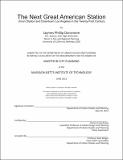The next great American station : Union Station and Downtown Los Angeles in the twenty-first century
Author(s)
Dunsmore, Jaymes Phillip
DownloadFull printable version (53.45Mb)
Alternative title
Union Station and Downtown Los Angeles in the twenty-first century
Other Contributors
Massachusetts Institute of Technology. Dept. of Urban Studies and Planning.
Advisor
Dennis Frenchman.
Terms of use
Metadata
Show full item recordAbstract
Ideas about a city are powerful forces, and have lasting impacts on the built environment. While not every vision is realized in the built form, every aspect of urban development is the reflection of a vision about what the city should be. This is especially true in Los Angeles. Today, the ideas and trends that shaped the development of that city, and many American metropolises, in the twentieth century are falling away, presenting the opportunity for new visions of downtown development and civic space to take form. This work seeks to understand the origins and effects of past visions for Downtown Los Angeles, critique the potential of current visions, and propose new ideas for urban development and public space, using the concepts of civic space and convergence as lenses and Los Angeles Union Station as a focal point. This work is divided into three parts. The first explores the visions and trends that shaped Los Angeles in the twentieth century and their influence on the city today. The second looks at current and emerging trends that are likely to inform the growth of the city in the twenty-first century, which suggest a new type of city is emerging: one in which economic activity, transportation networks and the city's cultures converge downtown. From this study, and an examination of two cities influenced by those trends (London and New York), are derived design principles for transit-oriented civic space networks in city centers. The third part narrows in on Union Station as a site, taking those principles and applying them to create a scenario for the future development of the station area, which is in part a projection of the current and emerging trends and in part an act of imagination, leaping beyond the status quo to envision a better city which does not yet exist, but could. In the conceptual design presented here, Union Station serves three important functions as both a gateway and a destination, a link between the city's past and future, and a cultural crossroads. The station becomes a focal element in a new model for urban development: the convergent city, in which Downtown Los Angeles is not the focus of everyday life, but reemerges as the center of civic life.
Description
Thesis (M.C.P.)--Massachusetts Institute of Technology, Dept. of Urban Studies and Planning, 2012. This electronic version was submitted by the student author. The certified thesis is available in the Institute Archives and Special Collections. Cataloged from student submitted PDF version of thesis. Vita. Includes bibliographical references (p. 147-149).
Date issued
2012Department
Massachusetts Institute of Technology. Department of Urban Studies and PlanningPublisher
Massachusetts Institute of Technology
Keywords
Urban Studies and Planning.